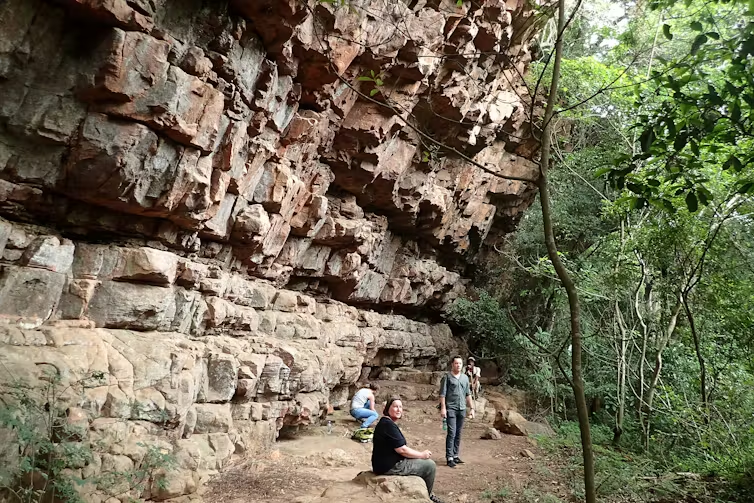In what is now Jordan, archaeologists discovered a child's body buried with hundreds of beads from about 9,000 years ago.
The reconstructed necklace. (Alarashi et al., PLOS ONE, 2023)
An international team headed by archeologist Hala Alarashi from Côte d'Azur University in France concluded that the youngster was likely a female who was around 8 years old based on the structure of her jaw.
Little can be inferred about the child's lifestyle from the bones that are still present because of the extent of time's devastation.
One of the few hints as to who she was and what her society's culture was are the beads, which imply that the Neolithic villagers of Ba'ja took great care to bury their children.
The majority of the more than 2,500 beads found in the burial were stained crimson and covered the child's chest and neck. Some of the beads were composed of calcite, turquoise, and hematite.
There was a slight, but discernible structure throughout the chaos. Researchers discovered two neighboring beads in the shape of tubes for every sequence of ten beads shaped like discs.
The beads would have needed to be strung, either sewed into the child's clothing, or hanging on a body part for such a meticulous arrangement.
Alarashi and her crew discovered the solution behind the kid's neck. A mother-of-pearl ring and a double-perforated pendant with numerous beads still attached were found here.
Scientists have pieced the magnificent jewelry back together, one bead at a time, using many strands of expertly placed beads.
Despite being a small settlement, Ba'ja was most likely inhabited between 7400 and 6600 BCE, and it is densely packed with archaeological relics. The route via the meandering gorges and sheer rock formations is the only way to get to the high plateau.
The multi-stranded pendant reconstructed. (Alarashi et al., PLOS ONE, 2023)
However, not every resident of this long-gone hamlet was interred there.
The majority of the burials that have been discovered beneath Ba'ja's dwellings are infants and young children who are interred with a variety of grave goods.
In the historic village, the 8-year-old girl's burial was discovered in 2018 behind a room. Their painstaking excavation's findings have finally been published.
The beads this infant was buried with were undoubtedly "part of an ornament that has collapsed and disorganized gradually after the decomposition of the body," according to Alarashi and colleagues.
They note that the necklace she wears is unlike anything else they have ever discovered in the Levant, which at one time included both the Eastern Mediterranean and West Asia.
The color harmony and meticulous symmetry of the beads convey a tremendous deal of riches and prosperity.
The mother-of-pearl ring, however, is considered by scholars to be the ornament's genuine masterpiece. It was likely previously iridescent and is enormous and quite delicate. Its surface is expertly etched with little designs that resemble filigree or lace.
The study's authors state that "the aesthetic sensibility is undeniable."
The enormous number of beads, their intricate arrangement, and their harmony and beauty are similar to later decorations that appear in Mesopotamia and Egypt.
Field pictures showing the distribution of the beads. (Alarashi et al., PLOS ONE, 2023)
The jewelry stands out in this Levant village that is much older.
The researchers write that their thorough examination of the ensemble "has allowed us to reimagine one of the oldest and most impressive Neolithic ornaments, believed to have been created to endow a highly eminent 8-year-old child of the community."
"Despite its intricate design, such a necklace was not made for exchange or trade purposes, but rather as a component of the child's burial, serving as an important testament to the cultural practices of the time," says the author.
The necklace is currently on display in Jordan at the New Petra Museum.








